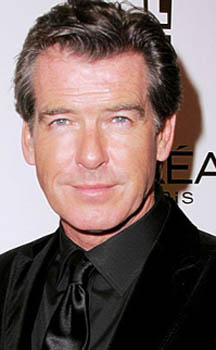LONDON, Reuters) – As a new documentary shows, the real story behind the James Bond film franchise is almost as dramatic as the 007 fantasies themselves, full of twists and turns, personality clashes, heroes, villains, beautiful women and narrow escapes.

“Everything or Nothing” is released in theatres today, branded “Global James Bond Day” to mark 50 years since the world premiere of “Dr. No” which introduced author Ian Fleming’s suave, sophisticated secret agent to the masses.
An anniversary Blu-ray box set, a swanky charity auction at Christie’s and the new “007” fragrance for men are some of the ways in which Bond is being celebrated, underlining the lasting appeal of a character who has been constantly reinvented.
A measure of the fictional spy’s popularity in Britain came during the opening ceremony of the London Olympics, when Bond actor Daniel Craig and Queen Elizabeth shared a short, comic and hugely popular scene filmed in Buckingham Palace.
Craig’s first two outings on her majesty’s secret service both earned around $600 million at the box office and “Skyfall”, the 23rd official Bond film, hits theatres in a few weeks.
But the new documentary, directed by Stevan Riley and featuring interviews with five of the six official Bond actors, underlines how the series was not always so secure.
“We’ve been through two bankruptcies of the studio, and we’ve been through various attacks by competing series so we’ve had our ups and downs,” said long-time Bond producer Michael G. Wilson of the franchise’s more serious setbacks.
“And of course we’ve also painted ourselves into a corner a number of times when you have to jump out of it,” he told Reuters in a telephone interview.
Everything or Nothing director Riley agreed: “Bond always lives to fight another day and there were many threats,” he said earlier this week at the film’s London premiere.
“I mean, how did Bond survive for … 50 years? Everyone takes that very much for granted, but there were many obstacles in the way.”
CUBBY AND HARRY
Alongside Fleming, the two most important figures in Bond movie history were producers Albert “Cubby” Broccoli of the United States and Canadian Harry Saltzman.
Their shared passion for the character and novels was what got Bond to the big screen, and after “Dr. No” in 1962 came “From Russia With Love” in 1963 and “Goldfinger” in 1964.
By that time James Bond was an international cultural phenomenon, providing audiences with the adrenalin-fuelled escapism of daring stunts, fast cars, futuristic gadgets, tailored suits, beautiful women and exotic locations.
Sean Connery, the first Bond, eventually tired of his global celebrity and had a nagging sense that he was being short-changed, so after the fifth Bond movie “You Only Live Twice” the disenchanted star stepped down.
His departure was to be the first of several major casting choices for the producers that could make or break the series.
George Lazenby was hired for a single film “On Her Majesty’s Secret Service” before Connery returned with “Diamonds Are Forever” and Roger Moore took over for the next seven films.
Playing the role of 007 was not always easy.
Five Bonds – Connery was notable by his absence – were interviewed for the documentary, with Lazenby reminiscing about wild days of womanising and admitting he blew his chance.
At a party Roman Polanski called him “the redundant actor”, and Lazenby joked he went to look the word up in a dictionary.
Pierce Brosnan bluntly recounted the phone call he received informing him he was sacked, while Craig said he was “knocked for six” by the negative reaction to his appointment in 2005.
It was during Moore’s tenure that Saltzman invested in new ventures, landing him with huge debts and forcing him to sell his share in the Bond franchise.
The fact that he sold to United Artists, the Hollywood studio, and not his long-term partner was a major blow to Broccoli and the two men fall out.
“I think the Harry and Cubby thing was probably the worst in a way because they both made this great success and then one of them got into financial trouble and … it caused a rift,” said Wilson, who is Broccoli’s stepson.
The split meant “The Spy Who Loved Me”, released in 1977, was a major gamble, and its opening sequence, where Bond skis over a cliff only for his Union Flag parachute to open, was seen as a metaphor for the high-stakes game Broccoli was playing.
BATTLE OF BONDS
In 1983, a face-off between “Octopussy” starring Moore and “Never Say Never Again” starring Connery and made by rival producers became known as the “battle of the Bonds”, and again could have seriously dented Broccoli’s franchise.
Kevin McClory, one of the original writers of the “Thunderball” storyline, had long been a thorn in the side of the “official” series and took Fleming to court in 1963 some nine months before the author died.
The six-year gap between “Licence to Kill” and Pierce Brosnan’s 1995 debut “GoldenEye” coincided with the collapse of Communism and much soul searching among the Bond creators over how he could be relevant after the Cold War.
The Brosnan “re-boot” proved to be a hit, and with Broccoli’s health deteriorating, he handed over the reins to Wilson and daughter Barbara who still control the franchise today. Broccoli died in 1996.

